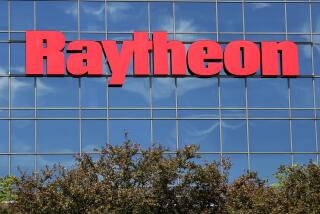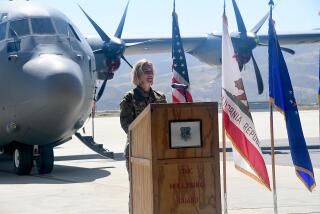Navy Ordered Not to Buy Cheaper Item : GSA Told Base to Purchase $348 Vacuum Rather Than $79 Model
- Share via
The General Services Administration (GSA) refused to allow a Navy commander at Miramar Naval Air Station to purchase a $79 vacuum cleaner last year, and instead instructed him to order a $348 model from a government supply catalogue, according to internal memos provided to The Times.
Cmdr. Jerry L. Fronabarger, one of two officers dismissed from Miramar earlier this month in connection with the purchases of two aircraft ashtrays for $659 apiece, requested a GSA waiver in May, 1984, to buy an industrial vacuum cleaner manufactured by Johnstone Supply of San Diego.
But R.H. Ross, chief of the GSA’s supply determination branch, told Fronabarger in a June 14, 1984, memo: “Federal property management regulations . . . specifically prohibit the GSA from granting waivers based on cost considerations alone. Since there appears to be no appreciable difference between the GSA item and the one you desire . . . your request cannot be granted.”
The vacuum cleaner case was cited by Rep. Bill Lowery (R-San Diego) in a July 18 letter telling Defense Secretary Caspar W. Weinberger that supply abuses are spread throughout the government and not limited to Miramar. In the letter, he asked for an explanation for the dismissals of Fronabarger and Capt. Gary E. Hakanson.
“If the Navy supply system and the GSA require Navy professionals to buy overpriced parts and equipment, how can those same professionals be blamed for improper procurement practices?” Lowery asked.
Fronabarger, in a telephone interview Wednesday night, said he was never given a “practical” reason for being told to purchase the more expensive model vacuum cleaner.
“It didn’t make any sense then and it doesn’t make any sense now,” Fronabarger said from a hotel room in Texas.
Vince Burns, deputy director of procurement for the GSA’s Federal Supply Service in Washington, blamed Ross for failing to properly investigate the difference between the two vacuum cleaner models. Burns said the more expensive Bissell Inc. vacuum cleaner has a 1.7 horsepower motor and 10-gallon storage tank compared to a 1.3 horsepower motor and six-gallon capacity in the Johnstone brand.
“It was a mistake on our part,” Burns said. “If Miramar determined that the light-duty industrial type vacuum was sufficient for their needs, they should have been able to go out and buy it.”
But Burns confirmed that purchasing policies do not permit federal agencies to buy less expensive items outside the GSA supply catalogue when the models are the same as those listed in the government manual. Burns said that this policy protects contractors who submitted the lowest bids to provide government supplies.
“It’s absolutely flabbergasting that we’ve got regulations that when GSA says it is substantially the same piece of equipment you can’t buy it even though it’s $270 cheaper,” Lowery said Thursday in a telephone interview. “I’m amazed at that kind of non-thinking. That is a mindless policy.”
Fronabarger said that a wet/dry vacuum cleaner was needed to clean up plumbing spills in Miramar’s public works division. Because of GSA’s action, no vacuum was purchased. He said “less cost-effective” measures were used by making maintenance personnel do the cleanup work by hand.
Since March, the GSA has added lower-priced industrial vacuum cleaners to its catalogue listing, Burns said. Federal agencies can now buy a vacuum cleaner manufactured by Shop-Vac Corp. in Williamsport, Pa., for $73.47.
In the last year, the GSA has received 550 requests from government agencies to purchase items outside the government catalogue, Burns said. Of those, 355 were approved.
Burns said the bulk of the requests involved higher priced items than those that are available through the GSA.
Providing further documentation of widespread supply abuses, Lowery’s July 18 letter to Weinberger listed six additional purchases of high-priced aircraft ashtrays. These included one purchased by Norfolk Naval Air Station in July, 1980, for $519.92 and another for $637.79 in February, 1982, by the aircraft carrier Kitty Hawk.
Three other ashtray purchases were made at Miramar--three in August, 1978, at $394 apiece, two in November, 1981, at $569 apiece and two in May, 1982, at $616 apiece.
A spokesman for Grumman Corp., supplier of the ashtrays, said the price differences were due to inflation and the quantities ordered.
Mike Drake, a Grumman spokesman in Bethpage, N.Y., said that if the company is able to verify the purchase of the six additional ashtrays listed in Lowery’s letter, it will offer a credit to the Navy.
Grumman recently repaid the Navy $100,000 for purchases including seven ashtrays, two wrench sockets for $800 and an elevator ground lock for F-14 Tomcat fighter planes for $2,410.
Although a Grumman audit of all the purchases found that the firm followed government-approved pricing procedures, Grumman decided to refund the money because of the “embarrassment and controversy” surrounding the purchases, Drake said.
Publicized reports of the Miramar ashtray purchases in May led to the firings of Fronabarger as supply officer, Hakanson as commanding officer and Rear Adm. Thomas J. Cassidy Jr. as commander of Miramar’s supply wing.
In announcing the dismissals on May 30, Weinberger said, “There was no excuse for (the ashtray purchases). It was back in 1981 . . . the item was identified specifically, and the outrageous price was identified, and there were two signatures on it. Nobody paid the slightest attention to the basic idea that the price bore no relationship whatever to the value of the item procured, or indeed the need for that item.”
But when it was learned that Fronabarger and Hakanson did not begin working at Miramar’s supply division until mid-1982, the Navy launched an investigation to determine who was responsible for the purchases.
According to excerpts of the 16-inch thick investigation report provided by Lowery, the Navy probe found that all three had performed “superbly” and recommended that they be exonerated.
Three weeks after the report was finished, Navy Secretary John Lehman announced that he had reinstated Cassidy and upheld Weinberger’s dismissal of Fronabarger and Hakanson.
Lehman said he would make the investigative report public after the announcement, Lowery said. Last week, Lehman told Lowery that the decision to release the findings was “out of his hands” and now up to Weinberger, Lowery said.
In his July 18 letter to Weinberger, Lowery reiterated his plea to make the report public.
“I can’t understand for the life of me the rationale of why (Fronabarger and Hakanson) should not have copies and why the public shouldn’t have copies,” Lowery said.
A Pentagon spokesman said on Wednesday that Weinberger had not yet received Lowery’s letter. “Maybe (Lowery) wants to talk to the Postal Service,” the spokesman said.
Lowery also asked Weinberger in the letter why Fronabarger’s attempt to purchase the vacuum cleaner at a savings of $269 was not approved.
“What has not been admitted is the fundamental injustice meted out to the Miramar officers who were not the only Navy buyers of these ashtrays,” Lowery wrote. “Why were the officers at Miramar singled out for disciplinary action?”
More to Read
Inside the business of entertainment
The Wide Shot brings you news, analysis and insights on everything from streaming wars to production — and what it all means for the future.
You may occasionally receive promotional content from the Los Angeles Times.










